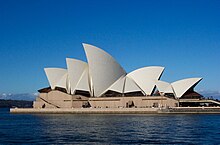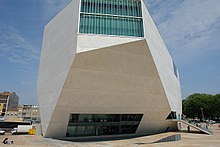Arup Group: Difference between revisions
9000 staff replaced with 10000 staff |
No edit summary |
||
| Line 26: | Line 26: | ||
[[Image:Sydney Opera House Sails.jpg|thumb|Sydney Opera House]] |
[[Image:Sydney Opera House Sails.jpg|thumb|Sydney Opera House]] |
||
[[Image:Coventry Cathedral NewOld.jpg|thumb|Coventry Cathedral, showing the new building by Arup in the background.]] |
[[Image:Coventry Cathedral NewOld.jpg|thumb|Coventry Cathedral, showing the new building by Arup in the background.]] |
||
[[Image:mill.bridge.from.tate.modern.arp.jpg|thumb|The Millennium Bridge, London]] |
[[Image:mill.bridge.from.tate.modern.arp.jpg|thumb | 200px |The Millennium Bridge, London]] |
||
==Fellows== |
==Fellows== |
||
Revision as of 15:26, 18 August 2008
| File:Arup.png | |
| Company type | Private, owned in trust |
|---|---|
| Industry | Design, Engineering and Business consultation |
| Founded | 1946 by Sir Ove N. Arup |
| Headquarters | London 92 Offices in 37 countries |
Key people | Terry Hill, Chairman Mike Shears, Chair of the Trustees |
| Revenue | GB£572 million (2007)[1] |
Number of employees | ca. 10,000 |
| Website | www.arup.com |
Arup is a professional services firm providing engineering, design, planning, project management and consulting services for all aspects of the built environment. The firm is present in the Americas, Australasia, East Asia, Europe and Middle East, and now has over 10,000 staff based in 92 offices in 37 countries. Projects have been undertaken in more than 160 countries.[1]
History
The firm was founded in 1946, as Ove N. Arup, Consulting Engineers by Sir Ove Nyquist Arup. Sir Ove set out to build a firm where professionals of diverse disciplines could work together to produce projects of greater quality than was achievable by them working in isolation. In 1963, together with the architect Philip Dowson, Arup Associates was formed to offer multi-disciplinary architectural and engineering services. In 1970, the firm reformed as "Ove Arup & Partners" and in the same year, Ove Arup delivered what is known as "The Key Speech", setting out the values and future vision for Arup.



Fellows
Arup Fellow is a life-long honorary title awarded to very few individuals in the firm. It acknowledges the highest design and technical achievements of an Arup person, not only within the firm, but also in the industry as a whole. They are considered role models with world-class expertise who put theory into effective practice.
The current fellows are:
- Cecil Balmond
- Tristram Carfrae
- Pat Dallard
- Naeem Hussain
- Alisdair McGregor
- Mike Glover
- Andy Sedgwick
- Brian Simpson
- Michael Willford.
Mike Glover is the recipient of the 2008 Institution of Structural Engineers' Gold Medal.

Notable projects


It is best known for its design work for the built environment. Projects to which it has contributed include the Sydney Opera House, which is largely credited with launching Arup into the premier league of engineering consultancies.[2]
Notable projects in the Americas
- De Young Museum, San Francisco
- California Academy of Sciences, San Francisco
- Y2E2 Building, Stanford, Palo Alto
Notable projects in Asia
- Beijing National Aquatics Centre, Beijing, China
- Beijing National Stadium, Beijing, China
- CCTV Headquarters, Beijing, China
- Dongtan Ecocity, China
- Guangzhou TV & Sightseeing Tower, Guangzhou, China
- HSBC Main Building, Hong Kong
- Singapore Flyer, Singapore
- Rajiv Gandhi International Airport, Hyderabad
- Kansai International Airport, Osaka, Japan
Notable projects in Europe
- 30 St Mary Axe, London
- Angel of the North, Gateshead, UK
- Casa da Música, Porto, Portugal
- Pompidou Centre, Paris
- High Speed 1, UK
- Millennium Bridge, London
- Nou Mestalla Stadium, Valencia, Spain
- Oresund Bridge, Denmark / Sweden
- Snowdon Summit Building, Wales
- Scottish Parliament Building, Edinburgh, Scotland
- Brunel's SS Great Britain, Bristol, UK
Awards

The Casa da Música, designed by Arup and Office for Metropolitan Architecture was nominated for the 2007 Stirling Prize.
Arup's work with The Druk White Lotus School, Ladakh, won them Large Consultancy Firm of the Year 2003 at the British Consultants and Construction Bureau - International Expertise Awards, 2003 building on their triple win atthe 2002 World Architecture Awards.[3]
Arup was awarded the Worldaware Award for Innovation for its Vawtex air system in Harare International School.[4]
Arup Fire has won the Fire Safety Engineering Design award four times since its creation in 2001.[5] The 2001 inaugural award was won for Arup's contribution to the Eden Project in Cornwall, UK, the world's largest greenhouse. In 2004, the design for London's City Hall was appointed joint winner. In 2005, the Temple Mills Eurostar Depot won. The 2006 winning entry was for Amethyst House, a nine storey building with an atrium from the ground to the top, in Manchester, UK.[6] More recently, Dr Barbara Lane, Associate Director with Arup, won the Royal Academy of Engineering Silver Medal[7] for her outstanding contribution to British engineering on design of structures for fire.
Related companies
Arup was one of the first engineering consultancies to adopt a holistic multi-disciplined approach to engineering design. Over the years, a number of its staff have left to form other companies, often with significant parallels with Arup.
In 1976, Edmund Happold (engineer for the Pompidou Centre) and six other engineers from the group left Arup to form Buro Happold in Bath. Mark Whitby in turn left Buro Happold to form Whitby Bird.
In 1999, Chris Wise (engineer for the Millennium Bridge) and Sean Walsh left Arup to form Expedition Engineering in London.
References
- ^ a b "Arup Ownership & finance". The Arup Group. Retrieved 2007-03-26.
- ^ Jones, Peter (2006). Ove Arup, Master Builder of the Twentieth Century. New Haven, CT: Yale University Press. ISBN 0300112963.
- ^ "World Architecture Awards" (Press release). Arup. 05 Aug 2002. Retrieved 2007-03-27.
{{cite press release}}: Check date values in:|date=(help) - ^ "The Worldaware Award for Innovation". Worldaware. 2002. Retrieved 2007-03-27.
- ^ "Innovation key to FSE Design Award winners". FSE: Fire Safety Engineering. 2006-11-15. Retrieved 2007-03-27.
- ^ "Fire Safety Engineering Design Awards". Arup. 2006-11-08. Retrieved 2007-03-27.
- ^ "Less is more for fire protection". Royal Academy of Engineering. 2008-06-05. Retrieved 2008-07-03.
